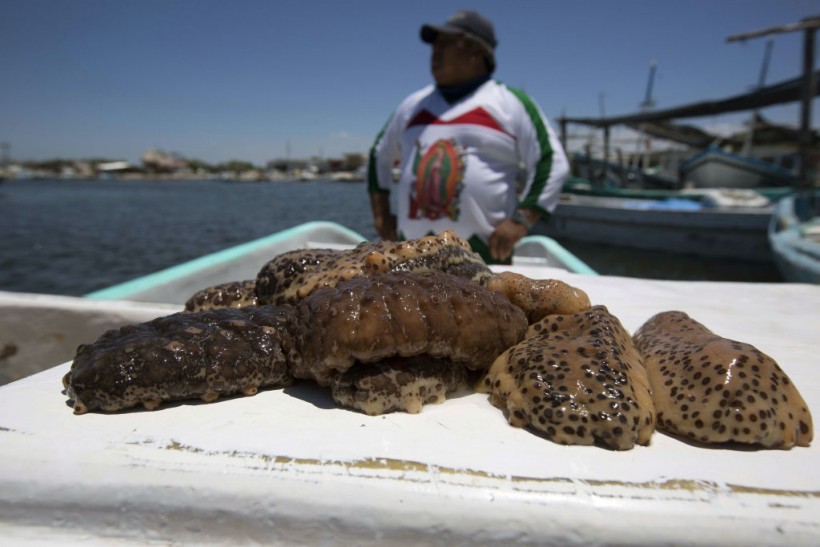A team of scientists from the University of the Philippines, The Marine Science Institute, has conducted a comprehensive study of the chemical composition of a local sea cucumber species, Stichopus cf. horrens, and found that it contains diverse classes of valuable small molecules that may have biomedical applications.
Researchers discover bioactive compounds in Philippine sea cucumber
 (Photo : HUGO BORGES/AFP via Getty Images)
(Photo : HUGO BORGES/AFP via Getty Images)

Sea cucumbers are marine animals that belong to the phylum Echinodermata, which also includes starfish, sea urchins, and sand dollars.
They are widely consumed as food and medicine in many Asian countries, especially in China, Japan, Korea, and the Philippines.
However, the scientific evidence for their health benefits is still limited and mostly based on traditional knowledge.
The researchers used a high-throughput technique called liquid chromatography-mass spectrometry (LC-MS/MS) to analyze the metabolites, or the small molecules produced by the sea cucumber's metabolism, in its body wall and viscera.
They also employed bioinformatics tools such as molecular networking and chemometrics to identify and compare the metabolites across different samples.
They found that the sea cucumber had an abundance of phospholipids, such as phosphatidylcholines (PCs), phosphatidylethanolamines (PEs), phosphatidylinositols (PIs), and phosphatidylserines (PSs), in its crude extracts.
These compounds are important for the structure and function of cell membranes, and some of them have anti-inflammatory and pain-relieving properties.
The researchers also discovered that the body wall of the sea cucumber contained terpenoid glycosides and saponins, which are known to have anti-cancer effects by inducing apoptosis, or programmed cell death, in tumor cells.
Moreover, they detected sulfated alkanes and sterols, which are similar to kairomones and other signaling molecules that are involved in the ecological response and morphological transformations of the sea cucumber in the presence of predators and environmental stress.
Also Read: Sea Cucumbers Now the Face Of Aquacentric Organized Crimes
Implications and future directions
The study, which was published in the open-access journal PLOS ONE, is the first to provide a comprehensive metabolomic profile of the Philippine sea cucumber, Stichopus cf. horrens, and to reveal its potential as a source of bioactive molecules for biomedical applications.
The researchers hoped that their findings will stimulate further research on the sea cucumber and its metabolites, as well as their mechanisms of action and therapeutic effects.
They also suggested that the sea cucumber could be used as a model organism for studying the biosynthesis and regulation of various metabolites in marine animals.
The study also highlights the importance of conserving and managing the sea cucumber resources in the Philippines, which are facing threats from overexploitation, habitat degradation, and climate change.
The researchers recommend the implementation of sustainable harvesting practices, such as size limits and closed seasons, as well as the establishment of marine protected areas and community-based management schemes.
Moreover, the study opens up new opportunities for developing the sea cucumber industry in the Philippines, which has been declining due to the low quality and quantity of the products.
According to the study, the use of hatchery-produced juveniles for restocking and ranching programs, as well as the improvement of the post-harvest processing and marketing of the sea cucumber products.
Sea cucumbers are not only a valuable food source, but also a potential treasure trove of novel drugs for human diseases.
By exploring the chemical diversity and bioactivity of the Philippine sea cucumber, the researchers have uncovered a new avenue for marine biotechnology and bioprospecting.
Related Article: Overharvesting Threatens Tropical Sea Cucumbers in the Great Barrier Reef
© 2024 NatureWorldNews.com All rights reserved. Do not reproduce without permission.

![Tsunami Hazard Zones: New US Map Shows Places at Risk of Flooding and Tsunamis Amid Rising Sea Levels [NOAA]](https://1471793142.rsc.cdn77.org/data/thumbs/full/70325/280/157/50/40/tsunami-hazard-zones-new-us-map-shows-places-at-risk-of-flooding-and-tsunamis-amid-rising-sea-levels-noaa.jpg)



